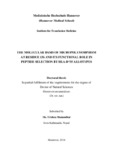Please use this identifier to cite or link to this item:
http://archive.nnl.gov.np:8080/handle/123456789/363| Title: | THE MOLECULAR BASIS OF MICROPOLYMORPHISM AT RESIDUE 156 AND ITS FUNCTIONAL ROLE IN PEPTIDE SELECTION BY HLA-B*35 ALLOTYPES |
| Authors: | Manandhar, Trishna |
| Keywords: | immune system Human Leukocyte Antigen (HLA) |
| Issue Date: | 25-Mar-2019 |
| Abstract: | HLA class I molecules are characterized by an extensive polymorphism, making every allele unique in their immunological function to present antigenic peptides to immune effector cells. Genetic diversity of HLA class I molecules offers on one hand protection against pathogens by increasing the repertoire of presented antigenic peptides, since every allele has a distinct peptide pattern. Therefore, this characteristic of HLA class I molecules can be utilized in peptide vaccination strategies or cellular anti-viral therapies. On the other hand, the polymorphic diversity of HLA class I molecules represent the main barrier to hematopoietic stem cell transplantation. Selection of permissive donor:recipient pairs for stem cell transplantation involves meticulous matching of HLA types. HLA class I polymorphism impacts on the diversity of antigenic peptides and furthermore on the interaction with the antigen presenting pathway of that Tapasin is a dedicated component. Tapasin facilitates peptide loading with high affinity peptides for the presentation of peptide-HLA complexes with a long half-life time. Tapasin-independent peptide loading can result in the selection of an alternate peptide repertoire, consequently those peptide-HLA complexes are characterized by short half-life times, thus circumventing T cell tolerance. Certain polymorphisms represent non-permissive transplantation scenarios and are associated with acute graft versus host disease. One of the most incompatible mismatches is located on the α2 helix of HLA class I alleles, position 156. The reason for that is that this position directly influences peptide loading, peptide features and thus impacts on the whole peptide-HLA landscape presented to immune effector cells. This could be described previously for the HLA-B*44 and the A*24 group. |
| URI: | http://103.69.125.248:8080/xmlui/handle/123456789/363 |
| Appears in Collections: | 500 Natural sciences and mathematics |
Files in This Item:
| File | Description | Size | Format | |
|---|---|---|---|---|
| PhD thesis_ Trishna Manandhar.pdf | 4.92 MB | Adobe PDF |  View/Open |
Items in DSpace are protected by copyright, with all rights reserved, unless otherwise indicated.